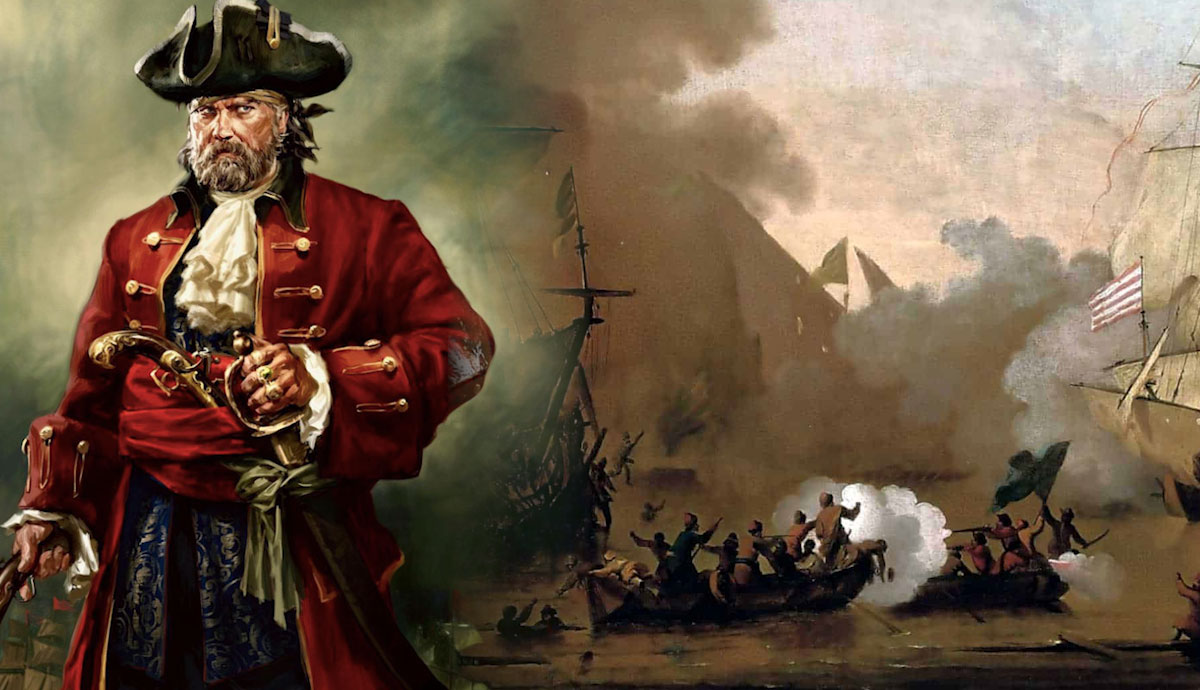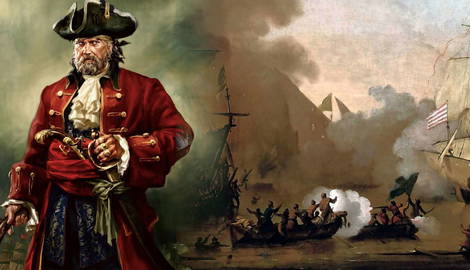
Throughout the entirety of human civilization, bandits have existed. People with few morals have clung to trade routes, swooping down on caravans and making off with the booty, often leaving death in their wake. The same is true for pirates who have plied their dangerous and often deadly trade on the sea routes of the world’s oceans.
In the 17th and 18th centuries, for over 80 years, the world’s oceans were a dangerous place for merchants. The advent of colonization had brought with it new opportunities for trade, and ships laden with spices, furs, tobacco, silver, and gold became targets for rival colonial powers as well as bandits of the sea, striking out on their own to seek their fortune over millions of square miles open ocean which could not be policed.
This era would be known as the Golden Age of Piracy.
Why Did the Golden Age of Piracy Start?

The Golden age of Piracy has its roots in the Spanish and Portuguese colonization of the Americas. During the 16th century, Spain and Portugal became the first global powers in Europe, colonizing new lands and opening international trade routes as they did so. Their endeavors were largely without incident between each other due to the 1494 Treaty of Tordesillas, in which the Pope conveniently drew a vertical line on the world map, dividing it in half. All the lands west of the line would belong to Spain, and all the land east of it was free to be exploited by the Portuguese.
And so the two empires happily plundered and pillaged their way to economic supremacy, colonizing new lands and committing genocide in the process. For a century and a half, this state of affairs went unchallenged by other European nations who had neither the finances nor the navy to form overseas colonies and trade routes of their own.

This era, of course, did not last. Other European powers became colonizers as well and began their own ventures. The Netherlands, France, and Britain all began to vie with one another and challenge Spain and Portugal as the dominant power.
In the 1650s, after the Wars of Religion were over, many European countries were free to concentrate on expanding their trade enterprises. Overseas ventures were a way to make exceptional amounts of money. But wherever there is money, thieves are also waiting to take it for themselves. The poorer elements of Ireland, Wales, the Netherlands, and Britain saw opportunities in piracy and simply followed the riches. The Golden Age of Piracy was born.
The Age of Buccaneers

“Any of the freebooters preying on Spanish ships and settlements, especially in 17th century West Indies” – Merriam-Webster
The Golden Age of Piracy was kickstarted by buccaneers. The word “buccaneer” comes from the Spanish bucanero, which in turn is derived from the Caribbean Arawak word buccan, which refers to a wooden frame on which meat is smoked or roasted. As such, the word originally didn’t have the connotations of piracy. French buccaneers had established themselves on the island of Hispaniola as early as 1625, making their living hunting pigs and cattle. Living outside the law, they fell prey to Spanish attempts to eliminate them. As a result, buccaneers turned their efforts to piracy. They moved their base of operations to the nearby island of Tortuga, which was easily defensible, and began attacking Spanish shipping routes. With scarce resources on Tortuga, Buccaneers were solely reliant on their piratical trade to survive.

In 1655, The English captured Jamaica and provided the impetus for the enlargement and support for the buccaneer trade. The town of Port Royal in Jamaica became an important trading post for buccaneers selling their captured booty. Many buccaneers were also employed directly by English and French authorities to target Spanish ships, giving rise to the era of privateers who were pirates in the employ of a certain government, and attacked only the ships of nations that the government allowed them to. Captain Henry Morgan was a prime example of a privateer in the employ of the French and English governments. He was hired to attack Spanish ships at sea and assets on the Spanish Main. Unlike true pirates, privateers didn’t have to end up at the end of a rope. Henry Morgan was knighted and became governor of Jamaica.
The buccaneers of Tortuga called themselves the “Brethren of the Coast” and were made up mainly of English and French, but there were also a few Dutchmen. Their actions were successful, and the island of Tortuga was bitterly contested, changing hands between the buccaneers and the Spanish multiple times until 1664, when its status as a French colony was solidly defensible. Nevertheless, the French took a laissez-faire approach to piracy operating in and out of Tortuga, and the island would remain a base for pirates for decades to come. The focus of the Golden age of Piracy in the following years, however, would shift geographically into waters far from the Caribbean.
The Pirate Round

By the end of the 1680s, piracy was becoming less lucrative as settlements had been sacked so many times. Even the east coast of North America became less attractive. Adding to this, an earthquake in 1692 on Tortuga destroyed much of the pirating infrastructure.
Privateering also took a blow, as the cooperation between the French and the English ended, and traditional enmity was restored. As a result, many privateers turned into pirates and sought their riches outside of the Americas. The most obvious target was the Indian Ocean.
Indian trade offered rich pickings for pirates, and the Indian Ocean was poorly policed. The Golden Age of Piracy in the Indian Ocean saw many notorious pirates become hugely successful and wealthy. Of particular note are Henry Every, Robert Culliford, Thomas Tew, and William Kidd.
The Golden age of Piracy would shift back to the Caribbean as wars in Europe ended, and trade flourished in the region again. However, piracy was still a major factor in the Indian Ocean, with pirates operating out of Madagascar in particular.
The Wars of Spanish Succession End
From 1713 onward, the Wars of Spanish Succession ended, and peace between England and Spain saw a massive boom in piracy, as many seamen and privateers were relieved of their duties. Without employment, thousands turned to piracy.

Many of the most notorious pirates became famous during this era of the Golden Age of Piracy, such as Blackbeard, Bartholomew “Black Bart” Roberts, Henry Jennings, and Charles Vane.
Tied in with the transatlantic slave trade, the early 18th century saw a great surge of trade in the Atlantic between the Americas and the continent of Africa. From Europe, merchants sailed to Africa with manufactured goods and weapons. From Africa, they sailed to the New World with enslaved people, and from the New World, they returned to Europe with sugar, rum, tobacco, cocoa, and other goods new to Europe. Naturally, piracy followed these routes and preyed on merchant vessels.
As a result of the treaties signed at the end of the Wars of the Spanish Succession, England gained a monopoly on the Transatlantic slave trade. The market became saturated with ex-naval seamen looking for work aboard slave ships. The increase in labor drove wages down, and unscrupulous merchants cut corners, leaving sanitation to be a huge issue on these boats. As a result, the mortality rate of the sailors on these boats was almost as bad as the enslaved people. The desire for a freer, less filthy, and richer existence was an easy proposition to accept, and many of these sailors ditched their job as slavers and became pirates instead.
During the Golden Age of Piracy, conditions were generally much better on pirate ships than on naval or merchant ships. Rations were shared equally, and equality was strictly enforced. Captains were treated as equals and were voted in, thus creating an atmosphere of mutual respect, which was sorely lacking in their previous jobs.
The End of the Golden Age of Piracy

The Golden Age of Piracy was in sharp decline by around 1719. Initially, the end of the Wars of Spanish Succession had been problematic in that many sailors became pirates out of necessity. However, the colonial nations had had enough of piracy and invested heavily in stamping it out. Navies became larger again, and a huge body of experienced sailors was available.
Pirates were named and hunted. By the 1720s, pirates were being caught en masse. Although the Golden Age of Piracy came to such an abrupt end, Barbary pirates still operated around north Africa with the same vigor that they had since they started reaving in the early 17th century. They persisted until the early 19th century when their operations were wiped out in the First and Second Barbary Wars.

The Golden Age of Piracy was a difficult time to be a merchant on the high seas, but like all eras, it eventually passed. The notorious pirates ended up being hanged or killed in battle, while others went into hiding and ceased their operations.
The memory of this era of history has nevertheless persisted in the imaginations of people to this very day. Myths and legends have sprouted like weeds, and pirates (especially those in the Caribbean) have been romanticized in words, in song, and on screen.










